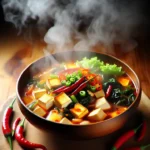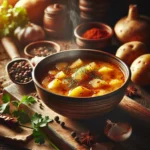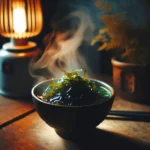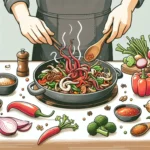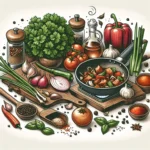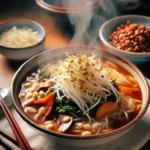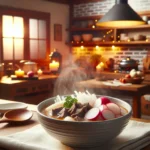Imagine a warm bowl of comfort on a chilly day, where each spoonful envelops you in a cozy embrace of flavor. This is the beauty of Mandu Guk, a beloved Korean dumpling soup that transcends mere nourishment. As the savory broth melds with perfectly crafted dumplings, it creates a harmonious blend that sings to the soul. In the following sections, you will discover the essential ingredients and step-by-step instructions to create this heartwarming dish. Let’s embark on a culinary journey that promises not just to satisfy your hunger, but to ignite your love for Korean cuisine. Dive in and let your taste buds dance with delight!
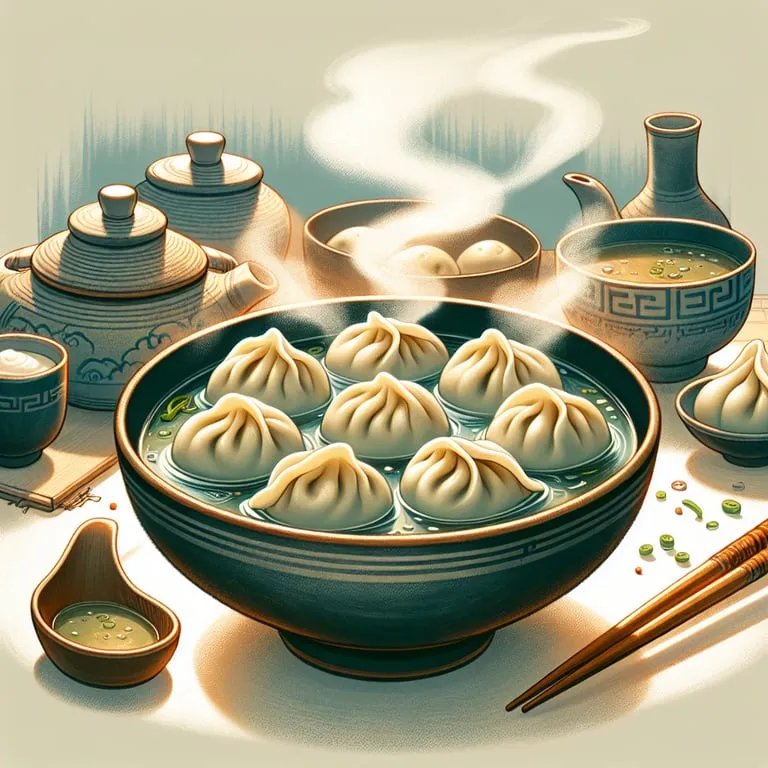
Ingredients for Mandu Guk
Creating the perfect Mandu Guk begins with sourcing the freshest and most vibrant ingredients! This delightful Korean dumpling soup is a harmonious blend of flavors, textures, and aromas that leaves everyone craving more. Let’s delve into the essential components that will elevate your Mandu Guk to new heights! 🌟
Dumplings (Mandu)
First and foremost, the star of the dish! You will need approximately 20-25 store-bought or homemade dumplings. For a richer flavor, consider using pork or beef mixed with chopped vegetables. If you’re looking for something lighter, chicken or tofu can work wonders too!
Broth
A good broth is paramount! You can use either a rich beef broth (about 6 cups) or a lighter, velvety vegetable broth, depending on your preference. If you feel adventurous, make your own broth using beef bones and root vegetables simmered for several hours. The comforting aroma will linger throughout your kitchen!
Aromatics
Get ready to infuse your broth with enticing flavors! Use 2 cloves of garlic (minced), 1 inch of ginger (sliced), and 1 medium onion (quartered). These will add depth and warmth to your soup base! Don’t forget to add a pinch of salt and a dash of black pepper for that extra zing! 🌶️
Vegetables
Fresh is key! Toss in a mix of vibrant and colorful vegetables. About 1 cup of sliced mushrooms, 1 cup of chopped napa cabbage, and 1 cup of sliced green onions should do the trick! In addition, a handful of spinach can add both color and nutrition to your bowl. These ingredients not only enhance the flavor but also bring a delightful crunch!
Seasoning
To awaken the flavors in your soup, add:
- 2 tablespoons of soy sauce 🥢
- 1 tablespoon of sesame oil for a nutty fragrance
- 1 teaspoon of gochugaru (Korean red chili flakes) for a *hint of spice!*
- A splash of rice vinegar for a bit of acidity to balance the flavors.
Optional Toppings
Elevate your Mandu Guk with toppings such as a soft-boiled egg, additional sliced green onions, or a sprinkle of sesame seeds. These little additions can make a big difference, transforming each bowl into a masterpiece!
With these carefully selected ingredients, you’ll create a Mandu Guk that is not only comforting but bursting with flavors! 💖 Prepare to wow your family and friends as they savor each spoonful of this delightful dish! As you gather your ingredients, let your culinary creativity shine through, and remember that the joy of cooking comes from the love you put into it!
Step-by-Step Cooking Instructions
Creating the perfect Mandu Guk requires careful attention and a touch of creativity! Let’s embark on this culinary journey together. 🍲
Step 1: Prepare the Mandu Filling
Start by finely chopping 1 cup of kimchi and squeezing out any excess liquid. Combine it in a bowl with 1 cup of ground pork or beef, 1/2 cup of tofu (preferably soft, crumbled), 2 chopped scallions, 1 tablespoon of minced garlic, and 1 tablespoon of sesame oil. Add a sprinkle of salt and pepper to taste! Mix everything well until it’s a homogenous filling. The flavors of the kimchi meld beautifully with the meat and tofu, so don’t hold back on the mixing!
Step 2: Wrapping the Dumplings
Grab a pack of mandu skin. If you’re feeling adventurous, you can make your own dough! 😊 Place a teaspoon of the filling in the center of a mandu skin. Use your finger to wet the edges with a bit of water. Carefully fold it over to create a half-moon shape, and pinch the edges together, ensuring no filling escapes (it’s a great opportunity to practice your culinary artistry!). Aim for about 20-25 dumplings, depending on your appetite.
Step 3: Creating the Broth
While your dumplings are being wrapped, it’s time to whip up the broth! In a large pot, start by heating 6 cups of chicken or vegetable stock over medium heat. Bring it to a gentle simmer. Add 2 tablespoons of soy sauce, 1 tablespoon of gochugaru (Korean red pepper flakes) for that spicy kick, and a pinch of salt. Feel free to adjust the amounts based on your personal spice tolerance! Everyone’s palate is unique, after all! 😊
Step 4: Cooking the Mandu
Once your mandu are ready, it’s showtime! Gently drop them into the simmering broth. Allow them to cook for about 5-7 minutes. The dumplings will float to the top when they’re done! If you’re using frozen mandu, they might take additional time—around 8-10 minutes. The water will become milky and fragrant as the dumplings release their juices into the broth!
Step 5: Serving the Dish
The moment of truth has arrived! Ladle the soup into bowls, making sure each portion has plenty of dumplings. Top with freshly chopped scallions and a sprinkle of sesame seeds for visual appeal and added crunch! For a touch of flavor, consider drizzling in a few drops of sesame oil just before serving. It’s all about those finishing touches! 🌟
Step 6: Enjoying the Meal
Mandu Guk is not just a dish; it’s a warm embrace on a chilly day! It’s best enjoyed hot, paired with a side of kimchi for those who can’t resist that extra punch of flavor! This soup is perfect for gatherings, or simply a cozy night in. It’s guaranteed to bring comfort to your table!
In the end, cooking Mandu Guk is more than following steps; it’s about crafting a dish filled with love and tradition. As you savor each spoonful, reflect on the joy of cooking and how it connects us all! 🌈
Serving Suggestions and Pairings
When it comes to Mandu Guk, the delightful Korean dumpling soup, the experience doesn’t stop at the bowl! 🤗 Elevating this comforting dish to new heights can be achieved through creative serving suggestions and thoughtful pairings. Let’s dive into a sensory journey that will make your taste buds dance with joy! 🎉
Presentation
To start off, consider serving Mandu Guk in traditional, shallow Korean bowls (often made of porcelain or ceramic) to allow the audience to appreciate the vibrant colors of the soup. A garnish of freshly chopped green onions or cilantro can add a pop of color and freshness, making the dish visually appealing. 🌿
Perfect Pairings
Pairing Mandu Guk with a side of Kimchi is an absolute must! This spicy and tangy fermented dish offers a brilliant contrast to the warm, savory depth of the soup. Did you know that over 90% of Koreans include Kimchi with their meals? This classic accompaniment not only enhances flavors but also provides a gut-friendly boost due to its probiotic content! 🥬✨
Crunch Factor
For those craving an extra crunch, serving a plate of crispy fried dumplings alongside is an excellent choice. Think of it as the yin and yang of dumplings – the tender, comforting Mandu Guk paired with the satisfying crunch of a fried Mandu. This textural contrast is sure to delight! 🍤
Side Dishes
For a more elaborate meal, consider offering an assortment of Banchan (side dishes). These could include seasoned spinach, pickled radish, and sweetened black beans. A colorful spread of Banchan creates a delightful communal dining experience and also showcases the vibrant palate of Korean cuisine. 🍽️😋
Drink Pairings
If you are an adventurous soul, why not explore unique drink pairings? A low-alcohol Korean beer, such as Cass or Hite, can complement the richness of the soup, while a crisp glass of Makgeolli (Korean rice wine) will enhance the meal with its mildly sweet flavor profile. The unique fermentation process of Makgeolli aligns beautifully with the hearty Mandu Guk, creating a harmonious experience. 🍺🍶
Enhancing Flavors
Also, don’t forget about the power of herbs and spices! A pinch of crushed red pepper flakes can be sprinkled on top for those who enjoy a little kick in their soup, while toasted sesame seeds add an irresistible nutty finish. These simple additions can transform the entire dining experience, taking it from good to absolutely memorable! 🌶️🌰
Ending on a Sweet Note
Lastly, think about dessert! After enjoying the sumptuous Mandu Guk, serving a sweet treat such as Hotteok (Korean pancakes filled with brown sugar) or Bungeoppang (fish-shaped pastries filled with sweet red bean paste) can beautifully round off the meal. These desserts not only satisfy the sweet cravings but also create a delightful end to a wonderful dining experience. 🍯🍰
In essence, serving suggestions and pairings for Mandu Guk not only enhance the meal but also create an immersive experience of the rich tapestry of Korean culinary tradition. The key is to balance flavors, textures, and colors to delight the senses. Embrace these ideas and transform your next meal into a celebration! 🌈🥳
Tips for Perfect Dumplings
Creating the ideal dumpling for your Mandu Guk is an art that combines technique, ingredients, and a dash of love. 🥢✨ Below are essential tips to ensure that your dumplings not only look enticing but also taste heavenly.
1. Quality Ingredients Matter
Start with high-quality ingredients! For the filling, using fresh vegetables and meats makes all the difference. Opt for about 200 grams of pork shoulder, finely minced, for a rich flavor or substitute with tofu for a vegetarian twist. Pair it with finely chopped onions (about 50 grams) and garlic for that aromatic punch! Fresh herbs like chives or green onions can enhance the freshness, so don’t hold back! 🌱
2. The Right Dough
The dough is the vessel of your dumpling experience. To make the perfect dumpling wrappers, use 2 cups of all-purpose flour combined with a pinch of salt and ½ cup of hot water. The heat from the water helps to create a more pliable dough, which is crucial for achieving that sought-after elasticity. After kneading for about 10 minutes, let it rest for at least 30 minutes, wrapped in a damp cloth. This resting period allows the gluten to relax, making rolling much easier! 🥟💦
3. Wrapping Technique
Mastering the art of wrapping takes practice but is immensely rewarding! Start by rolling out the dough into small circles of about 3 inches in diameter. Place a spoonful (roughly 1 tablespoon) of filling in the center, making sure not to overfill! Moisten the edges with a hint of water, fold the wrapper over the filling, and pinch it closed. For an elegant touch, create pleats by folding the edges multiple times, sealing in all that deliciousness! Each pleat adds not just form but also flavor! 🎨👌
4. Cooking Methods
There are various ways to cook dumplings, including steaming, pan-frying, or boiling. If you’re boiling them for Mandu Guk, ensure the water is at a rolling boil before gently adding the dumplings. Cook them for about 5-6 minutes – the dumplings should float to the surface, indicating they are cooked through! For a crispy finish, you might also consider pan-frying them for the first minute before adding water and covering them to steam. The combination of textures will take your dish to the next level! 🍽️🔥
5. Flavorful Broth
The soup is just as important as the dumplings themselves! Consider enhancing your broth by adding ingredients such as anchovy stock or kelp for umami. A splash of soy sauce and a few cloves of chopped garlic will elevate the flavor profile! Simmer for at least 30 minutes to allow the flavors to meld beautifully together before adding your dumplings! A sprinkle of sesame oil at the end will impart a warm, nutty flavor—don’t miss out! 🍜❤️
6. Creativity in Pairings
Dumplings aren’t just about the filling; they also lend themselves well to a variety of accompaniments. Consider serving your Mandu Guk with a side of kimchi for that spicy kick or some fresh greens to balance out the hearty soup! Fresh chili oil or a mix of soy sauce and vinegar can be marvelous dipping sauces to personalize each bite! The right pairings enhance your dining experience, so experiment and find your favorites! 🌶️🥗
7. Practice Makes Perfect!
Don’t be discouraged if your dumplings don’t turn out perfectly the first time! Each batch is a learning opportunity; even the ‘imperfections’ can lead to delicious results. Keep experimenting with different fillings, methods, and broths until you find your signature dumpling! Making dumplings can be a delightful activity to share with family and friends, creating memories filled with laughter (and tasty treats!) along the way. Enjoy the journey! 🎉🧡
Dumplings, in all their forms, are a comforting delight that brings warmth to the heart and soul. By focusing on the essentials and letting your creativity flow, you can find joy in every bite. Happy cooking!
As you savor the last spoonful of your homemade Mandu Guk, take a moment to reflect on the warmth and comfort that this dish brings. It’s more than just a meal; it’s a manifestation of love and tradition. Each dumpling, lovingly prepared, tells a story of heritage and togetherness. Embrace the joy of sharing this aromatic soup with friends and family, or simply enjoy it as a soulful dinner for one. Let it inspire you to experiment, to explore, and to create your own memories in the kitchen. Happy cooking, and may every bowl be filled with warmth and smiles!
